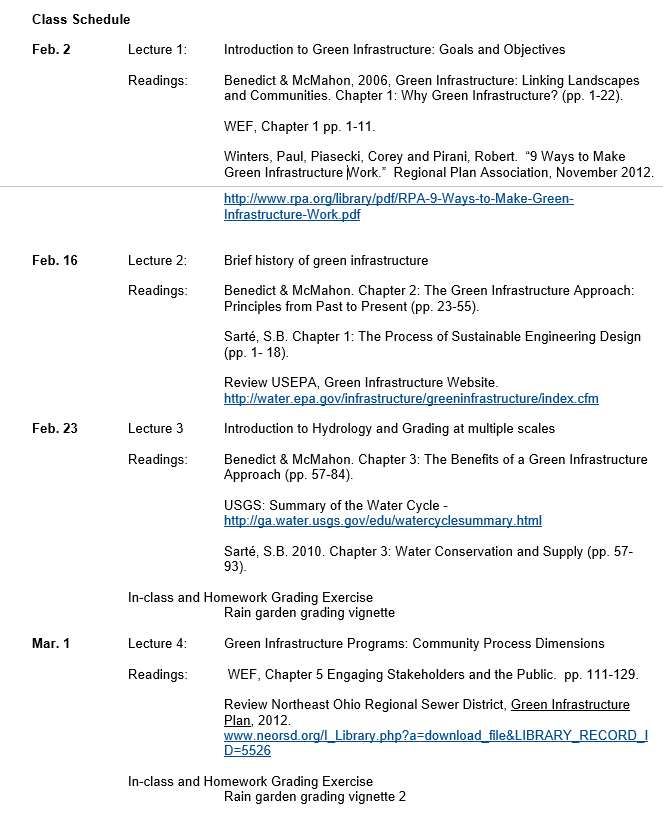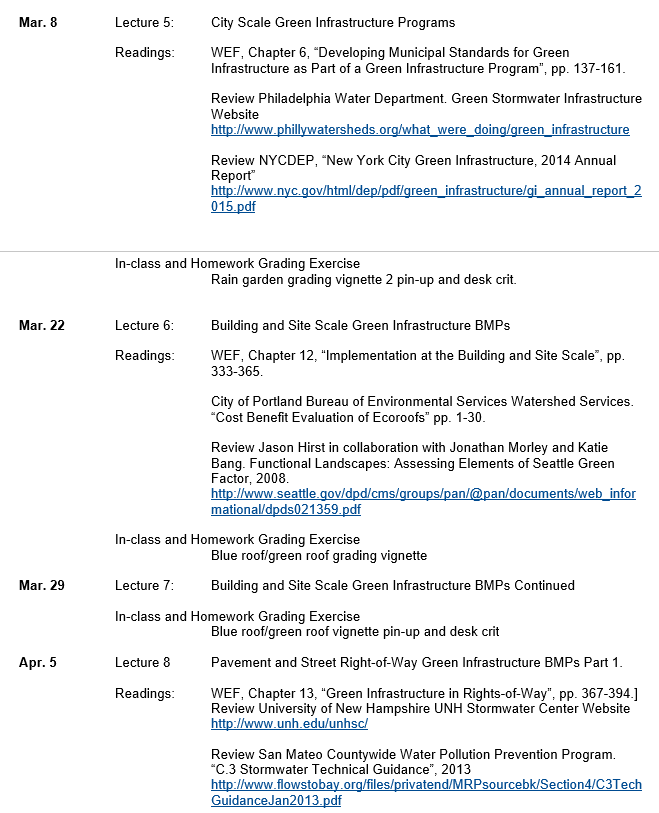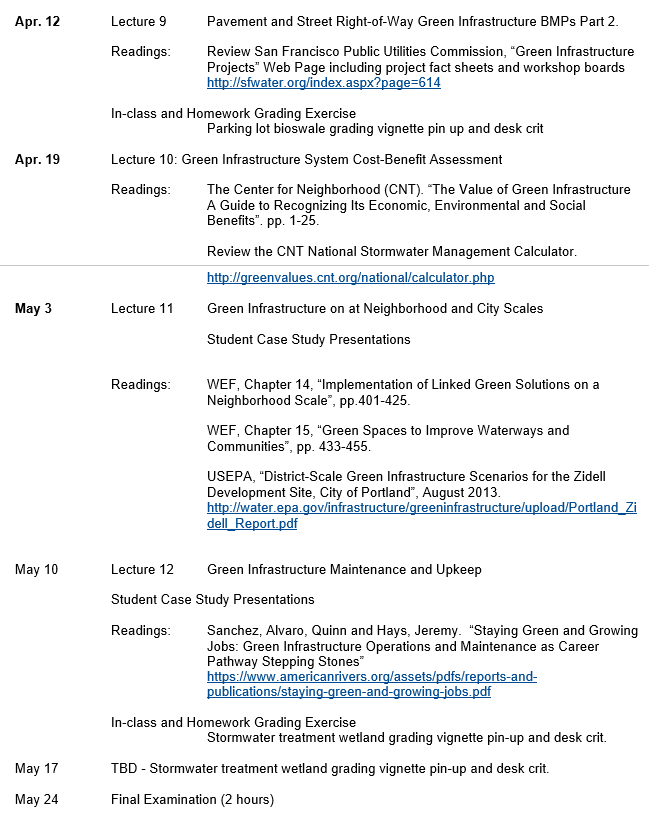Spring 2017. Subject to refinement/updating.
Instructor: Andrew Lavalee, FASLA, RLA
Schedule: Tuesday 3:00 p.m. to 5:50 p.m.
Location: TBA
3 credits 3 hours/week
Instructor
Andrew Lavallee, FASLA, RLA, Adjunct Professor
Email (all correspondence and assignments): %61l%61valle%65@ccny.cun %79.e%64u" rel="nofollow"> alavallee@ccny.cuny.edu
Work Email (for emergency contact only): alavallee@siteworkscm.com
Office Hours: By Appointment
Cell Phone: 917-842-9908
Description
Storm water runoff is a major cause of water pollution and associated ecological damage in urban areas. When rain falls in undeveloped areas, the water is absorbed and filtered by soil and plants allowing for a healthy hydrologic cycle. When rain falls in densely developed urban areas, overly compacted soils, roofs, streets, and pavements prevent the absorption of water leading to excessive run-off, disrupting the natural hydrological process. As a result, urban stormwater can be costly to manage effectively. Moreover, in most urban areas, storm water is drained through engineered collection systems and discharged into nearby waterbodies. The storm water carries trash, bacteria, heavy metals, and other pollutants from the urban landscape, degrading the quality of the receiving waters. Higher flows can also cause erosion and flooding in urban streams, damaging habitat, property, and infrastructure. Increasing global urbanization as well as sea level rise and more frequent flash flooding as part of predicted climate change will increase the challenges of managing storm water in our cities.
Green stormwater infrastructure offers cost effective ways to manage urban storm water while providing a broad range of other ecological, social and economic benefits to urban residents. When coupled with more traditional “gray” storm water infrastructure strategies, green infrastructure for stormwater management purposes has the power to transform how we conceive of urban design in the future.
This course will introduce students to the concepts, theories, and design methodologies for green stormwater infrastructure specifically aimed at managing urban storm water. A particular area of focus will be the relationship of green stormwater infrastructure and site grading design for improving hydrology as part of comprehensive approach to creating more sustainable cities. The course will look at a range of “green” urban storm water management strategies at a variety of scales ranging from building and site sized sales to neighborhood and city-wide scales. A case study approach will be used to study green infrastructure projects throughout the United States.
Goals of the course include:
- Briefly review the history urban green infrastructure its relationship to the larger historical frameworks of urban design, environmental planning and sustainable development.
- Give students a beginning understanding of the multifunctional social, ecological and economic benefits of urban storm water green infrastructure.
- Review ways to incorporate multiple spatial scales thinking for understanding ecological systems and when applying them to urban design and storm water planning problems.
- Review recent green infrastructure urban stormwater management programs implemented on the federal level and in urban areas including New York City, Portland, San Francisco, Philadelphia, Chicago and Cleveland.
- Explore a variety of design applications of green urban storm water management Best Management Practices (BMPs) including urban design considerations, treatment sizing and capacity, water quality benefits, maintenance, and costs.
- Develop student’s site grading skills as associated with urban stormwater site planning.
- Provide introductory tools to conceptually plan and design urban green infrastructure systems focusing on storm water management; evaluate policies; and develop implementation strategies.
- Help students recognize that the human component of sustainable, multifunctional urban landscapes is critical both for human health and for long term ecological preservation.
Objectives
Upon completion of the course, students will be able to:
- Properly use and understand green infrastructure and urban stormwater management terminology.
- Demonstrate a functional knowledge base of the challenges and opportunities presented by urban stormwater management.
- Identify opportunities for the use of green infrastructure for stormwater management in urban areas, including selection of appropriate BMP measures core consideration
- Critically evaluate the use of stormwater management BMPs within an urban design framework.
- Understand basic community outreach and implementation strategies for integrating green infrastructure storm water management into the public design process.
- Preliminarily size, design and grade urban storm water green infrastructure features including green roofs, rain gardens, bioswales, and storm water treatment wetlands.
- Navigate through existing on-line urban stormwater program resources available for developing detailed green infrastructure solutions on future projects.
Course Requirements
This is a lecture format course including one 3 hour lecture per week. Students will be responsible for completing weekly reading assignments and participating in group discussions based on the reading content. Students will also be required to complete the following assignments over the course of the semester:
- Completion and submission of guided reading responses prior to each class meeting.
- Completion of in-class and take-home design vignette problems including system sizing and site grading design
- Preparation and presentation of an urban green infrastructure case study in PowerPoint Format
- Final exam.
Grading
Grading Breakdown
Grading for the class will be determined according to the following criteria:
- Class Participation: 10%
- Guided reading responses: 15%
- Design Vignettes: 40%
- Case Study Presentation 10%
- Final Exam: 25%
Grading Criteria:
- Participation includes taking part in class discussions with regard to lecture material and reading assignments, and case study presentations.
- Written Material: Guided reading responses will be evaluated for spelling and grammar accuracy, clarity of intent and relevance to the assignment.
- Graphic Material: In-class case study presentations and Grading vignettes will be evaluated for general neatness, overall quality of presentation, and technical accuracy.
Incompletes: There will be no Incomplete given for a course except for a documented medical excuse at the discretion of the instructor. You are required to attend all classes at the allocated times. Absences need to be notified as mentioned in the paragraph above in schedule.
Attendance and timely submission of assignments: More than two unexcused absences in a course will result in a failing grade (two absences is equal to over 13% of total class time). Due to the nature of reviews, late assignments will not be reviewed for a grade. Each student must turn in what is completed or receive a failing grade for the particular assignment. Names of the student should be clearly indicated on all assignments.
Grading Standards
This schedule conforms to CCNY 2008-2010 Graduate Bulletin:
Grade Explanation (refers to class performance) Quality Points
A+ Rare, near perfect achievement 4.00
A Exceptional 4.00
A- Excellent 3.70
B+ High caliber 3.30
B Satisfactory 3.00
B- Below average 2.70
C+ Not satisfactory 2.30
C Poor 2.00
F Course failure 0.00
Readings
Reading List:
Primary readings will consist of excerpts from three primary texts including:
Benedict, Mark A. and McMahon, Edward T. Green Infrastructure: Linking Landscapes and Communities. Washington: Island Press, 2006.
Sarté, S.B. Sustainable Infrastructure: The Guide to Green Engineering and Design. Hoboken, NJ: Wiley Press, 2010.
Water Environment Federation (WEF). Green Infrastructure Implementation. Alexandria, VA: Water Environment Federation, 2014.
Additional Readings:
Additional readings will include review of green infrastructure program websites and documents including:
The Center for Neighborhood Technology (CNT). “The Value of Green Infrastructure A Guide to Recognizing Its Economic, Environmental and Social Benefits”, 2010.
http://www.cnt.org/sites/default/files/publications/CNT_Value-of-Green-Infrastructure.pdf
The Center for Neighborhood Technology (CNT). National Stormwater Management Calculator, 2009.
http://greenvalues.cnt.org/national/calculator.php
City of Portland Bureau of Environmental Services Watershed Services. “Cost Benefit Evaluation of Ecoroofs”, November 2008.
http://www.portlandoregon.gov/bes/article/261053
Hirst, Jason in collaboration with Jonathan Morley and Katie Bang. “Functional Landscapes: Assessing Elements of Seattle Green Factor”, 2008.
http://www.seattle.gov/dpd/cms/groups/pan/@pan/documents/web_informational/dpds021359.pdf
Northeast Ohio Regional Sewer District, Green Infrastructure Plan, 2012.
www.neorsd.org/I_Library.php?a=download_file&LIBRARY_RECORD_ID=5526
NYCDEP, “NewYork City Green Infrastructure, 2014 Annual Report”
http://www.nyc.gov/html/dep/pdf/green_infrastructure/gi_annual_report_2015.pdf
Philadelphia Water Department. Green Stormwater Infrastructure Website
http://www.phillywatersheds.org/what_were_doing/green_infrastructure
Sanchez, Alvaro, Quinn and Hays, Jeremy. “Staying Green and Growing Jobs: Green Infrastructure Operations and Maintenance as Career Pathway Stepping Stones.” April, 2013.
San Mateo Countywide Water Pollution Prevention Program. “C.3 Stormwater Technical Guidance”, 2013
http://www.flowstobay.org/files/privatend/MRPsourcebk/Section4/C3TechGuidanceJan2013.pdf
University of New Hampshire, UNH Stormwater Center Website (multiple .pdf resources).
USEPA, Green Infrastructure Website.
http://water.epa.gov/infrastructure/greeninfrastructure/index.cfm
USEPA, “District-Scale Green Infrastructure Scenarios for the Zidell Development Site, City of Portland”, August 2013.
http://water.epa.gov/infrastructure/greeninfrastructure/upload/Portland_Zidell_Report.pdf
Winters, Paul, Piasecki, Corey and Pirani, Robert. “9 Ways to Make Green Infrastructure Work.” Regional Plan Association, November 2012.
http://www.rpa.org/library/pdf/RPA-9-Ways-to-Make-Green-Infrastructure-Work.pdf
Course Outline
Last Updated: 01/29/2024 10:43


